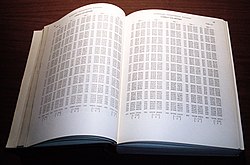Mathematical table
Mathematical tables are lists of numbers showing the results of a calculation with varying arguments.
History and use
The first tables of
Tables of common logarithms were used until the invention of computers and electronic calculators to do rapid multiplications, divisions, and exponentiations, including the extraction of nth roots.
Mechanical special-purpose computers known as
One of the last major efforts to construct such tables was the Mathematical Tables Project that was started in the United States in 1938 as a project of the Works Progress Administration (WPA), employing 450 out-of-work clerks to tabulate higher mathematical functions. It lasted through World War II.[2]
Tables of special functions are still used. For example, the use of tables of values of the cumulative distribution function of the normal distribution – so-called standard normal tables – remains commonplace today, especially in schools, although the use of scientific and graphing calculators as well as spreadsheet and dedicated statistical software on personal computers is making such tables redundant.
Creating tables stored in
Trigonometric tables
Trigonometric calculations played an important role in the early study of astronomy. Early tables were constructed by repeatedly applying
A simple example
To compute the
However, this answer is only accurate to four decimal places. If one wanted greater accuracy, one could
From the Bernegger table:
- sin (75° 10′) = 0.9666746
- sin (75° 9′) = 0.9666001
The difference between these values is 0.0000745.
Since there are 60 seconds in a minute of arc, we multiply the difference by 50/60 to get a correction of (50/60)*0.0000745 ≈ 0.0000621; and then add that correction to sin (75° 9′) to get :
- sin (75° 9′ 50″) ≈ sin (75° 9′) + 0.0000621 = 0.9666001 + 0.0000621 = 0.9666622
A modern calculator gives sin(75° 9′ 50″) = 0.96666219991, so our interpolated answer is accurate to the 7-digit precision of the Bernegger table.
For tables with greater precision (more digits per value), higher order interpolation may be needed to get full accuracy.[3] In the era before electronic computers, interpolating table data in this manner was the only practical way to get high accuracy values of mathematical functions needed for applications such as navigation, astronomy and surveying.
To understand the importance of accuracy in applications like navigation note that at sea level one minute of arc along the Earth's equator or a meridian (indeed, any great circle) equals one nautical mile (approximately 1.852 km or 1.151 mi).
Tables of logarithms


Tables containing common logarithms (base-10) were extensively used in computations prior to the advent of electronic calculators and computers because logarithms convert problems of multiplication and division into much easier addition and subtraction problems. Base-10 logarithms have an additional property that is unique and useful: The common logarithm of numbers greater than one that differ only by a factor of a power of ten all have the same fractional part, known as the mantissa. Tables of common logarithms typically included only the mantissas; the integer part of the logarithm, known as the characteristic, could easily be determined by counting digits in the original number. A similar principle allows for the quick calculation of logarithms of positive numbers less than 1. Thus a single table of common logarithms can be used for the entire range of positive decimal numbers.[4] See common logarithm for details on the use of characteristics and mantissas.
History
In 1544, Michael Stifel published Arithmetica integra, which contains a table of integers and powers of 2 that has been considered an early version of a logarithmic table.[5][6][7]
The method of logarithms was publicly propounded by
The computational advance available via common logarithms, the converse of powered numbers or
See also
- Abramowitz and Stegun Handbook of Mathematical Functions
- BINAS, a Dutch science handbook
- Difference engine
- Ephemeris
- Group table
- Handbook
- History of logarithms
- Nautical almanac
- Matrix
- MAOL, a Finnish handbook for science
- Multiplication table
- Numerical analysis
- Random number table
- Ready reckoner
- Reference book
- Rubber bookHandbook of Chemistry & Physics
- Standard normal table
- Table (information)
- Truth table
- Jurij Vega
References
- ^ a b J J O'Connor and E F Robertson (June 1996). "The trigonometric functions". Retrieved 4 March 2010.
- ISSN 1058-6180.
- ^ Abramowitz and Stegun Handbook of Mathematical Functions, Introduction §4
- ^ E. R. Hedrick, Logarithmic and Trigonometric Tables (Macmillan, New York, 1913).
- ^ Stifelio, Michaele (1544), Arithmetica Integra, London: Iohan Petreium
- ^ Bukhshtab, A.A.; Pechaev, V.I. (2001) [1994], "Arithmetic", Encyclopedia of Mathematics, EMS Press
- ^
Vivian Shaw Groza and Susanne M. Shelley (1972), Precalculus mathematics, New York: Holt, Rinehart and Winston, p. 182, ISBN 978-0-03-077670-0
- ^ Ernest William Hobson (1914), John Napier and the invention of logarithms, 1614, Cambridge: The University Press
- S2CID 119326088
- Robertson, Edmund F., "Jost Bürgi (1552 – 1632)", MacTutor History of Mathematics Archive, University of St Andrews
- Campbell-Kelly, Martin (2003), ISBN 978-0-19-850841-0
External links
- Chisholm, Hugh, ed. (1911). . Encyclopædia Britannica (11th ed.). Cambridge University Press.
- LOCOMAT : A census of mathematical and astronomical tables.
